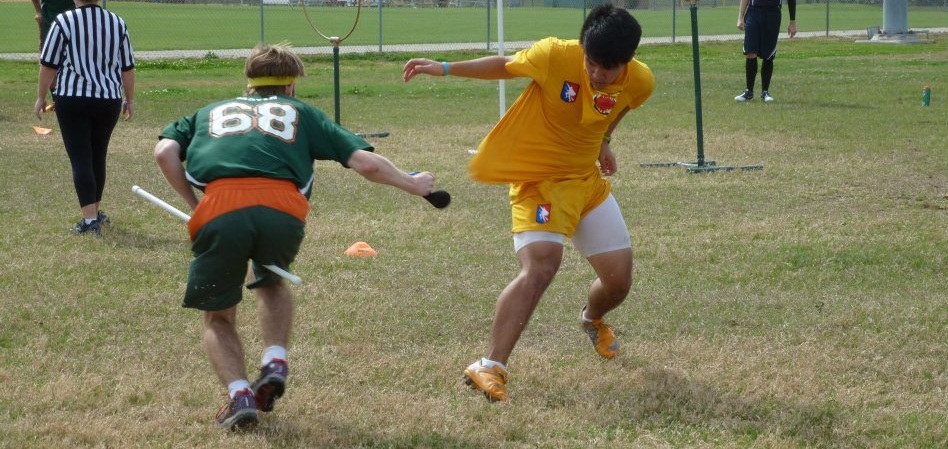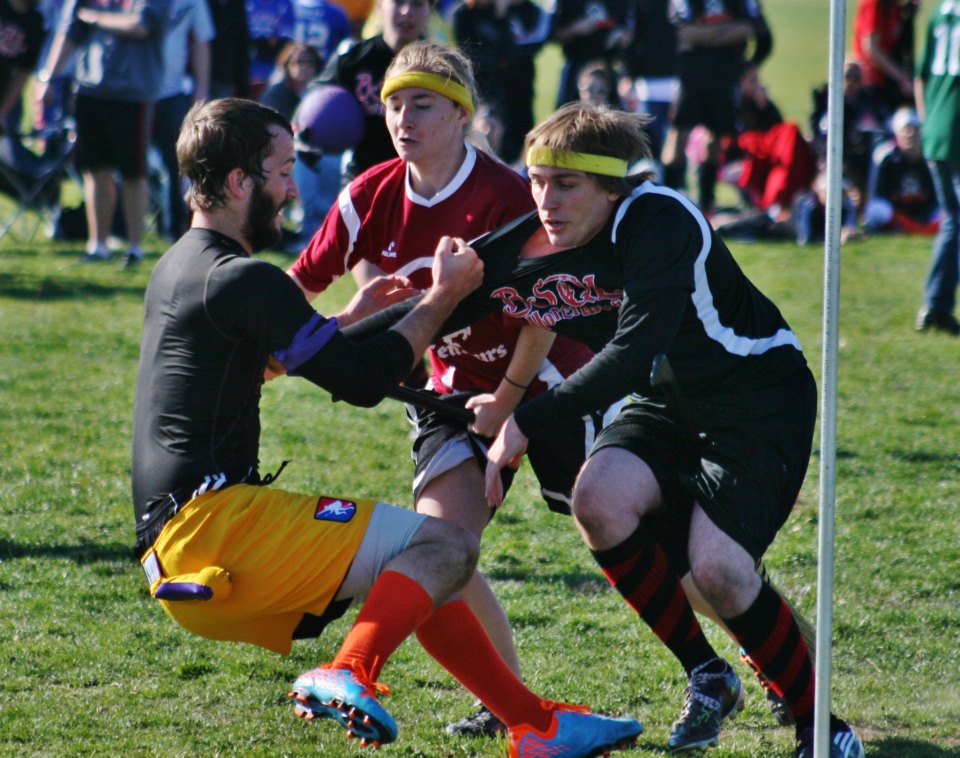- Rule, Britannia, no more?
- Unpopular Opinions: US Quadball Cup 2023
- Proven Contenders: University of Virginia
- Proven Contenders: Rutgers University
- Proven Contenders: University of Michigan
- Proven Contenders: Creighton University
- Different Perspectives: A Look Inside USA Ultimate
- Antwerp QC, Much of Belgian Core, Leaves Competitive Quidditch
Seeking the Perfect Seeker
- Updated: December 12, 2012


David Moyer (left) of the University of Miami is widely regarded as one of the game’s top seekers. Credit: Jeremy Sparks
The position of seeker is one of the most unique in all of sports. Not only do seekers get to end the game, but they get to score points while doing it. Games often come down to seekers, and so it’s important that your team has the best seeker possible.
But what does that mean? In the games early years, good seekers were typically cross country runners. They were the players who could keep up with the snitches, who were also often distance runners. Back then, teams were just getting their feet on the ground, and weren’t attracting the athletes we see in the game today. So, as such, if a team attracted a cross country runner, that person was almost always put at the seeker position.
It might seem like a bad idea to throw somebody into a position just because they can run, but at the time, the seeker wasn’t the pivotal position it is today. Many games were well out of snitch range, simply because the game had not grown enough yet, and everyone was still learning how to play and the sport’s basic strategies. The teams who had been around longer had a clear edge.
But today, there are many more teams with their feet under them, increasing the number of games at the highest level that come down to a snitch grab and making the seeker arguably the sport’s most important position.
So how do you choose the right seeker?
There are several criteria for a player to be a good seeker, the first one being aggression. Your seeker should be the most aggressive player on your team. He has to know that the game is coming down to him, and be prepared to show that he can handle it. A great seeker will never hesitate, and will give everything he has on every single attempt at a snitch. This means that your seeker should be sprinting the entire time he’s on the pitch, and giving everything he has to make the grab every time. This is also a reason to carry more than one player dedicated to seeking – in case your starter simply doesn’t have it anymore after a long pursuit.
If a seeker goes at the snitch as hard as he can, every single time, the snitch runner will wear down eventually, and be easier to grab. Additionally, if your seeker is sprinting at full throttle at all the time, while the opposing seeker isn’t, you’re going to end up with more attempts at the snitch, which means a higher chance to make a catch. It also forces beaters into additional beats, some of which may but their bludger control in danger. If a seeker can help get his team bludger control back, he’s made his life easier as well.
This may seem obvious, but a top tier seeker is also going to need to be in great shape. This goes hand-in-hand with aggression — if your seeker isn’t extremely fit, he won’t be able to go 100 percent all of the time. You may think that this is a no-brainer, and that this hasn’t changed since the cross country seeker days. But cross country won’t do you a whole lot of good once the snitch is back on the pitch – you need to be in sprinter’s shape. That is, you need to be able to sprint, virtually nonstop, the entire time you’re on the pitch. Yes, distance running will help with this, but in order to be the best seeker that you can possibly be, you need to work on your sprints, both your sprint speed and sprint distance.
The final key to a seeker in today’s game is unpredictability. What I mean by that is that you have to have a variety of moves to try to catch a snitch. If there’s one thing snitches love, it’s a seeker that comes at them doing the same thing every time. Once the snitch figures out a move that counters it, he’ll be virtually uncatchable.
As a seeker, you have to be creative and original to keep the snitch guessing. This could be as simple as switching hands a lot or as complex as a double-juke spin turned into a leaping grab attempt. Really, the possibilities are endless as long as you keep an open mind.
Amongst those seekers who can count themselves amongst the elite, there are specific subsets, or styles, that each play with. Below, I’ve listed some of the most common seem around the league:
Wrestling style: These seekers thrive on contact. They love being thrown because they know that when a snitch is making a throw, they can’t stop the seeker’s hands from reaching for a grab. These seekers always take snitches head-on, and are not afraid of grappling. One of the best wrestling seekers out there is Tyler Macy of No. 13 Ball State University and Team USA.

Ball State University’s Tyler Macy (right) isn’t scared to get physical with a snitch, even the likes of Daniel Daugherty (left). Credit: Shayla Johnson
Agility style: These seekers use their superior agility and quickness to get around snitches instead of going through them. Agility seekers are almost impossible to predict, and thus, hard to snitch against. They use a variety of jukes, hand switches and sharp movements to change their angle of attack quickly and frequently. The archetypical agility seeker is David Moyer of No. 5 University of Miami.
Power style: These seekers are the embodiment of aggression. They charge straight at the snitch every time, hoping to power through the snitches defenses to make the grab. These seekers are relentless, and use the speed and momentum they gain in the open field to overpower the snitch and make the grab. The perfect example of a power seeker is Billy Greco of No. 3 Villanova University and Team USA.
Sneaky style: This is a style that directly contradicts the aggressive attitude a seeker must have, but it can be used effectively in certain situations. Essentially, these seekers wait until the snitch is tied up before making their move, hoping that the snitch is distracted. To successfully pull this off, a seeker must have amazing speed to close the distance quickly, and great positioning and timing so that the snitch can’t see the attempt coming. But this style can also be dangerous, as it relies on the snitch holding off the opposing seeker to create an opening. Because of this,oIt should really only be used in specific situation. Jason Winn of No. 11 LSU has had some success with this approach, but it’s far from his only trick.
Seeker is a tricky position, and there are many different ways to go about it. We have only reached the tip of the iceberg, and as snitches further improve, seekers will get more and more creative. The results should be fun, and interesting, for fans and players alike.

3 Comments